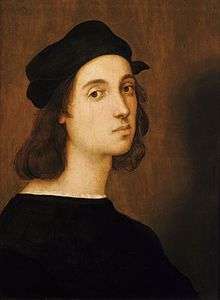Vision of a Knight (Raphael)
.jpg) | |
| Artist | Raphael |
|---|---|
| Year | 1504–1505 |
| Type | Egg tempera on poplar |
| Dimensions | 17.1 cm × 17.1 cm (6.7 in × 6.7 in) |
| Location | National Gallery, London |
The Vision of a Knight, also called The Dream of Scipio or Allegory, is a small egg tempera painting on poplar by the Italian Renaissance artist Raphael, finished in 1504–1505.[1][2] It is in the National Gallery in London. It probably formed a pair with the Three Graces panel, also 17 cm square, now in the Château de Chantilly museum.
There are a number of theories as to what the panel is intended to represent. Some art historians think the sleeping knight represents the Roman general Scipio Africanus (236–184 BC) who dreamed that he had to choose between Virtue (behind whom is a steep and rocky path) and Pleasure (in looser robes). However, the two feminine figures are not presented as contestants. They may represent the ideal attributes of the knight: the book, sword and flower which they hold suggest the ideals of scholar, soldier and lover which a knight should combine.
The most likely source for the allegory depicted is from a passage in the Punica, an epic poem recounting the Second Punic War by the Latin poet Silius Italicus.[3]
The panel was moved to England by William Young Ottley in 1800.
Raphael used an extensive palette of paints[4] to depict this colourful scene, pigments such as lead-tin yellow, ultramarine, verdigris and ochres were identified.[5] .
References
- ↑ Thoenes, Christof, Raphael (2005) Ed. Taschen. pp. 17
- ↑ Girardi, Monica, Raffaello. La ricerca della perfezione e la tenerezza della natura (1999) Ed. Associati. pp. 31
- ↑ "Iconography | Studying Raphael | Research | The National Gallery, London". Nationalgallery.org.uk. Retrieved 2012-10-17.
- ↑ Roy, A., Spring, M., Plazzotta, C. ‘Raphael’s Early Work in the National Gallery: Paintings before Rome‘. National Gallery Technical Bulletin Vol 25, pp 4–35
- ↑ Raphael, An Allegory (Vision of a Knight), illustrated pigment analysis at ColourLex
